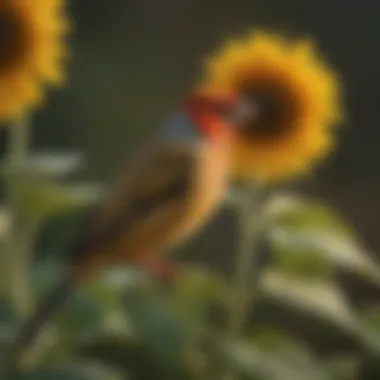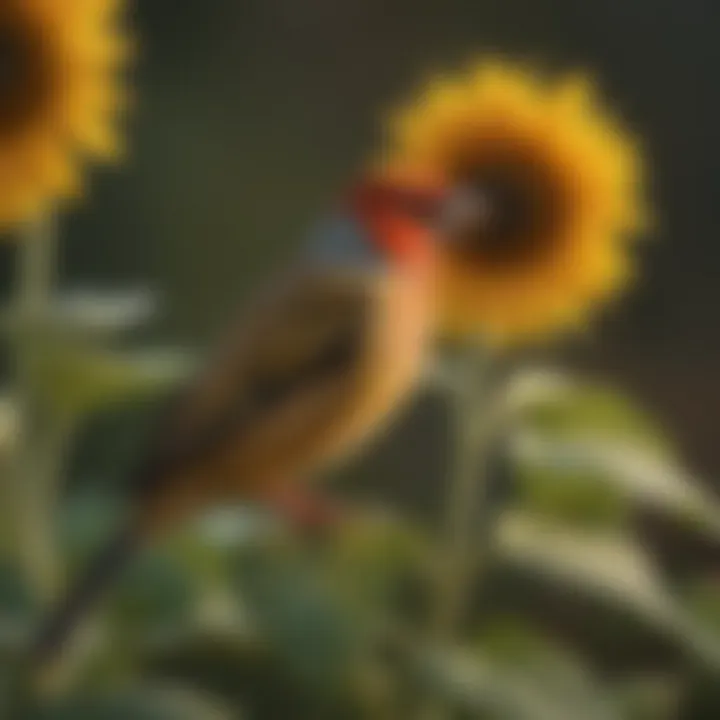Exploring the Avian World: A Guide to Bird Species


Intro
Birds captivate many people worldwide. Their diverse species, vibrant colors, and unique behaviors make them fascinating creatures. This guide aims to delve into the wonders of the avian world, offering insights into identification, behavior, and care for different bird species. It is not only a resource for potential pet owners but also for those who appreciate nature.
Understanding Your Pet
Understanding pet birds requires more than just an appreciation for their beauty. It is vital to comprehend their behavior, needs, and characteristics that help integrate them into a home setting. This knowledge creates a healthier and happier environment for both the birds and their owners.
Pet Behavior Basics
Birds exhibit distinct behaviors influenced by their species and environments. They are social creatures, often requiring interaction. Signs of stress, boredom, or illness can manifest in various forms like feather plucking, excessive squawking, or aggression. Recognizing these signs is crucial for a pet owner's role in a bird's well-being.
Common Breed Characteristics
Different bird breeds have unique characteristics. For example, budgerigars, or budgies, are known for being talkative and sociable. In contrast, cockatiels are generally more laid-back and affectionate. Understanding these breed-specific traits can significantly help potential owners choose a bird that suits their lifestyle and personality.
Species-Specific Needs
Each bird species has distinct requirements. The African Grey Parrot, for instance, thrives on social interaction and mental stimulation, while the Canary prefers a quieter environment. To cater to their needs, owners must research and adapt their approach to each species.
Pet Care and Maintenance
Proper care is essential for the health and longevity of pet birds. Ensuring they receive adequate nutrition, cleanliness, and grooming will ultimately support their physical and emotional needs.
Feeding Guidelines
Feeding birds a balanced diet is crucial. Most birds benefit from a mix of pellets, seeds, fresh fruits, and vegetables. It is essential to avoid foods that are toxic to birds, such as chocolate and avocado. A nutrient-rich diet is fundamental to overall health.
Grooming Essentials
Regular grooming is necessary for birds, as it helps maintain feather quality and cleanliness. Techniques like nail trimming and beak maintenance are vital. While some owners may seek professional help, routine grooming can often be accomplished at home.
Hygiene Practices
Maintaining hygiene in a bird's living space is crucial. Regular cleaning of cages and supplies prevents bacteria buildup and keeps odors at bay. Fresh water must be provided daily, and any soiled areas should be cleaned promptly to ensure the bird’s health.
Training and Development
Training birds is not just beneficial for the owner but also enriches the bird’s life, enhancing bonding and communication. Basic training can lead to improved behavior and reduced stress for both the owner and the pet.
Basic Commands and Skills
Teaching simple commands can be rewarding. Encouraging birds to step up onto a finger or respond to cues can foster a greater bond. Using positive reinforcement methods, like treats, often yields better results.
Behavioral Training Techniques
Understanding bird behavior is vital for effective training. Each bird responds differently to training techniques. Utilizing patience and consistency is key. It is crucial to be aware of stress signs while training, adjusting the session as needed.
Addressing Common Behavior Issues
Common behavior issues, like excessive squawking or biting, often stem from lack of mental stimulation or interaction. Identifying these problems and implementing strategies, like more playtime or training sessions, can lead to better outcomes.
Health and Wellness
Maintaining health is paramount in bird ownership. Regular veterinary care and vigilance can help prevent many health issues.
Routine Vet Check-ups
Birds should have annual checks with an avian veterinarian. These check-ups can catch health issues early. A veterinarian can also provide guidance specific to the bird's species.
Vaccination Needs
Some bird species require vaccinations to prevent diseases. Understanding what is necessary for the specific bird can play a significant role in its overall well-being. Consult with a vet to establish a suitable vaccination schedule.
Recognizing Signs of Illness
Being attuned to a bird’s behavior helps in recognizing potential health issues. Signs of illness can include lethargy, changes in appetite, or feather issues. Early intervention is critical for effective treatment and recovery.
Enrichment and Activities
Providing stimulation through activities is essential for a bird's mental health and well-being. Birds thrive on interaction, play, and exploration, making enrichment activities vital.
Indoor vs.
Outdoor Activities


Balancing indoor and outdoor activities is important. Indoor environments can offer safe spaces for exploration, while outdoor activities introduce new stimuli. Always ensure outdoor activities are supervised to prevent harm.
Interactive Toys and Games
Toys that encourage foraging and problem-solving are excellent for keeping birds engaged. Toys made of safe materials that promote chewing and exploration aid in mental stimulation and can help to prevent boredom.
Socialization Opportunities
Birds are social animals that benefit from socialization. Interaction with humans and other birds helps foster confidence and reduces stress. Group activities or even play dates with other bird owners can facilitate social development.
Understanding birds leads to deeper connections. Taking time to learn about their needs ensures they thrive as beloved companions.
Preamble to Birds
Understanding birds is a window into the complexity of nature. This introduction lays the groundwork for exploring various aspects of avian life, as birds represent a significant part of our ecosystem. From their colorful plumage to their melodious calls, birds are not only visually captivating but also biologically vital. In this section, we will focus on the diversity of birds and their ecological importance.
The Diversity of Birds
Birds come in thousands of species, each with distinct features and adaptations. According to current estimates, there are approximately 10,000 bird species worldwide. This diversity allows birds to inhabit nearly every corner of the planet, from tropical rainforests to arctic tundras. From the majestic eagle to the small hummingbird, the avian world is filled with fascinating variations.
Through this article, readers will encounter various bird types. Each species has unique characteristics, behaviors, and habitats. Learning about these aspects not only enriches our appreciation for birds but also deepens our understanding of biodiversity.
Selecting a few examples helps illustrate this diversity:
- Songbirds: Known for their complex vocal abilities, songbirds, such as the American Robin or the European Nightingale, are vocalists of the avian world.
- Birds of Prey: Includes species like the Bald Eagle and the Red-tailed Hawk. They are crucial for regulating populations of small mammals.
- Waterfowl: Such as ducks and swans, play a vital role in wetland ecosystems.
- Exotic Birds: Tropical species like the Macaw or the Quetzal are not only beautiful but also represent cultural significance in many regions.
Importance of Birds in Ecosystems
Birds play critical roles in maintaining ecological balance. They act as pollinators, seed dispersers, and pest controllers in many environments.
For instance:
- Pollination: Birds like hummingbirds and certain species of parrots assist in pollinating plants, which is essential for plant reproduction.
- Seed Dispersal: Birds eat fruits and transport seeds, facilitating plant growth across greater distances. This relationship is vital for ecosystem health.
- Pest Control: Many birds consume insects, thereby helping manage bug populations in agricultural and natural settings.
Understanding the roles birds play in ecosystems fosters a deeper respect for wildlife and highlights the importance of conservation efforts. Without birds, many natural processes would be disrupted, affecting the health of our environment.
In summary, the various bird species we encounter are not just subjects of hobby or curiosity. They are integral to the ecosystems they inhabit. Their rich diversity and critical roles emphasize the importance of studying and protecting avian life.
Classifying Birds
Classifying birds is essential for understanding the vast avian diversity that exists in our world. By organizing birds into categories, we gain insights into their evolutionary relationships and ecological roles. This classification facilitates effective study, conservation efforts, and fosters appreciation among bird enthusiasts and casual observers alike.
Birds can be categorized based on various criteria, including their physical characteristics, behaviors, and habitats. This structured approach aids in identifying species and recognizing their significance. The benefits of a systematic classification include easier access to information for researchers and avian lovers, and an organized framework for conservation initiatives.
Bird Orders and Families
Bird orders and families are the primary divisions in the classification hierarchy. They determine how species are grouped based on shared characteristics and ancestry. For instance, the order Passeriformes, which includes songbirds, is the largest bird order and consists of several families. Birds in this order often share features like a highly developed vocal apparatus and perching toes.
The classification extends to families, which group similar species together. For example:
- Fringillidae (finches) include common species like the American Goldfinch and House Finch.
- Corvidae (crows and jays) encompass intelligent birds such as the American Crow and Blue Jay.
Understanding these relationships is critical for birdwatchers. Recognizing a bird's family can offer clues to its behavior, habitat preferences, and vocalizations.
Morphological Classification
Morphological classification focuses on the physical traits of birds. This includes aspects such as size, shape, plumage color, and beak structure. By analyzing these characteristics, ornithologists can discern relationships among different species, identifying functional adaptations to their environment.
For example, the beak structure varies significantly among birds, tailored to their feeding habits:
- Hummingbirds possess long, slender beaks for nectar extraction.
- Predatory birds like eagles have hooked beaks for tearing flesh.
Morphological classification also aids in distinguishing similar species, which is vital for both research and birdwatching. Additionally, this classification method enables conservationists to identify species at risk based on physical traits that may be vulnerable to environmental changes.
Understanding the classification of birds not only enhances our knowledge of avian life but also supports global biodiversity efforts by allowing for more informed conservation decisions.
Common Types of Birds
Understanding the common types of birds is crucial for anyone exploring avian life. Each category reveals distinct characteristics, behaviors, and habitats that are valuable for pet owners, birdwatchers, and enthusiasts. Knowing the differences helps in making informed choices, whether it's selecting a pet bird or appreciating their role in nature.
Songbirds and Their Characteristics
Popular Species
Popular species of songbirds, such as the American Robin and the Common Nightingale, stand out due to their melodious calls and vibrant appearances. These birds are often easy to recognize due to their vocal talents, making them a delight among bird enthusiasts.


One key characteristic of popular songbirds is their adaptability. For instance, the House Sparrow is prevalent in urban areas, thriving alongside human activity. This adaptability benefits the species by increasing their chances of survival within various environments.
Unique features of popular songbirds include their diverse color patterns and distinct songs. Many of these birds exhibit sexual dimorphism, where males present brighter plumage than females, attracting mates through visual displays in addition to song. However, while their beauty is attractive, some species can also become competitive, vying for territory and resources.
Habitats and Behavior
The habitats and behavior of songbirds play a significant role in their survival and interaction with humans. These birds can be found in a range of environments, from forests to urban gardens. Their behavior, particularly migratory patterns, is critical for understanding how seasonal changes affect their populations.
A notable characteristic of these birds is their social nature. Many songbirds form flocks, especially during migration or feeding. This behavior offers them protection from predators and enhances foraging efficiency. The diversity in habitats they occupy allows them to interact with various ecological systems, influencing insect populations and seed dispersal. Nonetheless, their reliance on specific habitats makes them vulnerable to habitat loss and degradation.
Birds of Prey
Identification Features
Birds of prey, including eagles, hawks, and owls, are distinguished by their superior vision and strong talons. These identification features allow them to spot and capture prey from great distances. Their keen eyesight is especially beneficial for tracking small mammals, birds, and even fish, depending on the species.
A key characteristic of identification features is their size and shape. For example, the Bald Eagle possesses a large wingspan and a distinctive white head, making it easily recognizable. Understanding these features aids birdwatchers in identifying species accurately, enriching the overall birding experience. However, their size can also intimidate smaller bird species in the area.
Feeding Habits
The feeding habits of birds of prey significantly contribute to their position in the ecosystem. These birds often employ unique hunting techniques tailored to their prey type. Some, like the Peregrine Falcon, dive at high speeds to snatch prey mid-flight, showcasing their agility and precision.
Key characteristics of their feeding habits include a carnivorous diet and a preference for fresh, whole prey. They are also known to cache food for later consumption, which helps them survive in harsh conditions. However, this requirement for a meat-based diet can limit their distribution to areas with abundant prey availability.
Waterfowl and Aquatic Birds
Common Varieties
Common varieties of waterfowl, such as ducks, geese, and swans, present a fascinating group to explore. Their diverse appearances range from the colorful Mallard to the elegant Mute Swan. Recognizing these varieties aids in understanding their specific roles within aquatic ecosystems.
A notable characteristic of these birds is their adaptation to aquatic life. Features like webbed feet and waterproof feathers enable them to thrive in water environments. However, their dependency on lakes, rivers, and wetlands makes them vulnerable to pollution and habitat destruction.
Ecological Roles
Waterfowl and aquatic birds play essential ecological roles by maintaining the health of their environments. They help control insect populations, as many feed on insects and larva during breeding seasons, contributing to natural pest management. Furthermore, they often participate in nutrient cycling, transferring nutrients from water to land through their droppings.
One important characteristic of their ecological roles is their migratory behavior. Waterfowl migrate vast distances to access seasonal food and safe breeding grounds. This migration significantly impacts local ecosystems as their presence influences both plant and animal communities, benefiting biodiversity. Nevertheless, the loss of wetlands poses a threat to their survival and the ecosystems they support.
Exotic and Tropical Birds
Key Species
Exotic and tropical birds, such as the Macaw and the Cockatoo, attract immense interest due to their striking beauty and vibrant colors. These species are crucial for understanding the rich biodiversity of tropical regions. Enthusiasts often seek out these birds for their unique appearances and social behavior.
A key characteristic of these birds is their intelligence. Many species can mimic sounds, including human speech, making them captivating pets. Their intelligence also fosters social interaction, requiring owners to maintain mental stimulation through activities. However, their complex needs can be challenging for inexperienced pet owners.
Cultural Significance
The cultural significance of exotic and tropical birds is profound. Many societies revere these birds, associating them with spiritual beliefs and artistic expressions. In several cultures, birds like the Quetzal symbolize freedom and beauty.
Notably, their colorful plumage often inspires art, literature, and fashion, showcasing their broad cultural impact. Understanding this significance enhances the appreciation of these birds beyond mere aesthetic values. However, overexploitation poses risks, threatening their populations in the wild.
In summary, understanding the common types of birds enriches one's appreciation of avian diversity and the roles birds play in our ecosystems. From the melodic songbirds to the majestic raptors and colorful tropical species, each category offers unique aspects worth exploring.
Birds as Pets
Birds are increasingly popular as pets due to their unique characteristics and relatively low maintenance compared to other animals. The bond between humans and birds can be significant. Therefore, understanding their needs and behaviors is essential for prospective bird owners. This section examines important aspects of choosing a pet bird and the necessary care to provide optimal living conditions.
Choosing a Pet Bird
Selecting a suitable pet bird can greatly enhance the experience of pet ownership. Factors to consider include the bird's size, personality, and needs. Each of these considerations can impact the compatibility of the bird with your lifestyle.
Factors to Consider
When choosing a pet bird, it's crucial to assess the living environment and lifestyle. Space availability is a key factor; larger birds often require more room to move around. Also, the potential owner's time commitment should be evaluated. Birds require daily social interaction, enriching their lives and building bonds. The noise level of certain species also deserves attention, as some birds can be quite vocal.
Advantages and disadvantages: The right choice can lead to a fulfilling pet relationship. However, neglecting these factors can result in stress for both the bird and owner.
Species Suitable for Domestication
Certain bird species are excellent for domestic life, such as budgerigars, cockatiels, and lovebirds. These species are often social and adapt well to human companionship. Their playful demeanor and ability to learn tricks make them popular choices among bird enthusiasts.
The key characteristic of these species is their ability to bond with humans. This trait is significant for individuals seeking interaction with their pets. However, it's important to understand the commitment involved in keeping a pet bird, as many require considerable social engagement and mental stimulation.
Advantages: These species are usually easier to care for and more likely to thrive in a domestic environment. Disadvantages: Some birds may become lonely or bored without enough interaction.


Basic Care Requirements
Providing proper care for a pet bird is essential to keep them healthy and happy. Understanding feeding practices and socialization needs ensures their well-being in a domestic setting.
Feeding Practices
Diet plays a vital role in a bird's health. A balanced diet typically consists of seeds, pellets, fruits, and vegetables. Each species may have different dietary requirements; thus, researching the specific needs is necessary.
The key characteristic of feeding practices is variety. Introducing different foods keeps birds stimulated and satisfied. Birds that get a well-rounded diet tend to have healthier plumage and more energy. However, it is core to avoid giving them unsuitable foods, such as chocolate or avocado, which can be harmful.
Advantages: A diverse diet promotes overall health. Disadvantages: It may take time to identify which foods a pet bird prefers.
Socialization Needs
Socialization is crucial for a pet bird's happiness. Birds that feel isolated may develop behavioral issues. Spending time with them daily, engaging in play, and allowing them to interact with family members can prevent loneliness.
The key characteristic of socialization is interaction. Birds are naturally social creatures, and they prosper when they are part of a community. Regular interaction fosters trust, which can strengthen the bond between the bird and its owner.
Advantages: Well-socialized birds are often more affectionate and playful. Disadvantages: Socialization takes time and effort from the owner, which may not be feasible for everyone.
Regular interaction with pet birds not only enhances their well-being but also brings joy to both the bird and the owner. It creates a more fulfilling pet ownership experience.
Understanding these factors and care requirements can help potential bird owners make informed decisions. The insights provided in this section are crucial for cultivating a harmonious relationship with pet birds.
Conservation and Protection of Birds
Conservation and protection of birds are crucial aspects of environmental ecology and biodiversity. The myriad of bird species plays significant roles in ecosystems, serving as pollinators, seed dispersers, and indicators of ecological health. Their well-being is directly linked to the health of habitats that support various forms of life. Preventing the decline of bird populations serves not just the avian community, but also promotes overall ecological balance.
Threats to Bird Populations
Habitat Loss
Habitat loss occurs primarily due to urban expansion, logging, and agricultural development. These activities degrade natural habitats that birds depend on for nesting, feeding, and shelter. It holds critical importance in this context, as bird populations face declining numbers due to diminishing available habitats. The key characteristic of habitat loss is its rapid progression, often resulting in irreversible damage to ecosystems. This article emphasizes the urgency of awareness surrounding habitat loss, providing insights into areas most affected and the specific bird species at risk.
“Habitat loss is one of the greatest challenges faced by birds globally. It is essential to maintain natural spaces for their survival.”
The unique feature of habitat loss is the way it impacts multiple species, not just birds. It leads to a cascade of effects throughout an ecosystem. Therefore, recognizing this threat is beneficial because it allows us to focus conservation efforts where they are most needed.
Climate Change
Climate change is deeply intertwined with bird conservation. Changes in temperature and weather patterns disrupt migratory routes and breeding seasons for many species. It has broad implications for food availability and habitat suitability. The key characteristic of climate change is its gradual but pervasive impact, affecting not just birds, but entire ecosystems. Understanding climate change’s role in avian survival is essential for informed conservation strategies.
The unique feature of climate change is its global reach, impacting every region differently. This presents challenges but also opportunities for adaptive management strategies to support affected species. Highlighting the importance of climate change in this article enables a comprehensive understanding of the multifaceted threats to birds.
Efforts in Bird Conservation
Local and Global Initiatives
Local and global initiatives play vital roles in bird conservation by addressing threats through collaborative efforts. For example, national parks and wildlife reserves protect habitats for many species. International treaties, like the Migratory Bird Treaty Act, aim to protect migratory paths across borders. The key characteristic of such initiatives is their collective impact; they bring together different stakeholders, including governments, non-profits, and communities, to mobilize resources for conservation.
Unique features include specific projects targeting endangered species or restoring critical habitats. These efforts provide essential frameworks for effective conservation practices. Discussing these initiatives is beneficial as it highlights successful strategies and inspires further action in the community.
How Individuals Can Help
Individuals also have significant power in conservation efforts. Simple actions contribute to the broader goal of protecting bird populations. This includes actions like creating bird-friendly spaces, such as gardens that provide food and shelter. The key characteristic of individual involvement is its accessibility; anyone can participate in conservation efforts, regardless of expertise.
Unique features involve local birdwatching organizations that educate the public and promote community engagement. Initiatives like citizen science projects encourage people to record bird sightings, enhancing data collection for research. Understanding how individuals can help is important because it empowers people to make a difference.
End
The exploration of birds, as presented in this article, highlights the critical relationship between avian species and humanity. The various sections have illuminated the incredible diversity of birds and their relevance in ecosystems, as well as the personal joy they can bring to our lives. Understanding birds is not just an academic endeavor; it extends to appreciating their role in nature and the responsibilities we have towards their conservation.
The Future of Birds and Human Interaction
Looking ahead, the future of birds greatly depends on how we, as a species, engage with the environment. Human activities such as urbanization and agriculture have profound effects on bird populations and their habitats. Birds, often viewed as indicators of environmental health, provide us with valuable clues about the state of our ecosystems. Protecting avian habitats is crucial for maintaining biodiversity.
A stronger emphasis on education can lead to better understanding and nurturing of these species. For instance, encouraging community-based conservation efforts can help bring awareness to local bird species. Engaging children in bird watching programs can foster an appreciation for wildlife. It becomes a cycle; as we learn to appreciate birds, we become better stewards of the environment, ensuring that future generations can enjoy their beauty.
Encouraging Bird Appreciation
To foster a deeper appreciation of birds, we must enhance our public awareness and education initiatives. One effective method is through organized activities such as bird counts or local bird festivals. These events can introduce families and children to avian life, sparking curiosity and enthusiasm.
Here are some practical ways to encourage bird appreciation within communities:
- Create bird-friendly environments: Encourage planting native plants that provide food and shelter.
- Engage in local conservation programs: Participate in or support projects aimed at protecting bird habitats.
- Utilize social media platforms: Share pictures and knowledge about birds to reach a wider audience. Websites like reddit.com have communities focused on birdwatching and education.
- Leverage educational resources: Utilize websites such as britannica.com and en.wikipedia.org to facilitate learning about avian species.
Through these actions, we can cultivate a society that not only enjoys the beauty of birds but also recognizes their ecological importance. When individuals understand the impact of personal actions on bird populations, they are more likely to participate in conservation efforts, thus bridging the gap between avian life and human society.
“In every walk with nature one receives far more than he seeks.”
In sum, the bond between birds and humanity can lead to a mutually beneficial relationship. Protecting bird species ensures a healthier planet for us all.







